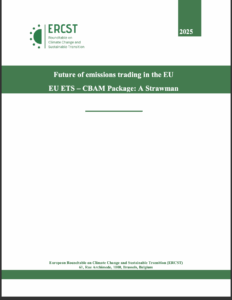
- This event has passed.
Preparing for the review of the EU ETS – use and division of revenues & reflections on the December EUCO conclusions
This meeting is under Chatham House Rules
This meeting is part of a series of webinars which are part of ERCST’s work stream on the revision of the EU Emission Trading System. Our aim is to bring together a group of stakeholders on a regular basis to discuss the most important issues on the table for the EU ETS revision. This webinar will be an opportunity for participants to engage in a discussion on the division and use of the EU ETS revenues, including through dedicated funding mechanisms.
Currently, auction revenues are divided among Member States according to their share of historical emissions. Revenues can be used at a Member State’s own discretion, although at least 50% should be used for climate- and energy-related purposes. Up to 25% can also be used by Member States to compensate for the indirect costs firms incur through increased electricity prices.
Moreover, provisions have been introduced in the past to increase the amount of allowances to be auctioned by lower-income Member States (the Solidarity Provision) or to set aside auctioning revenues to finance investments in particular low-carbon technological solutions (the Innovation Fund), and energy system investments in Central and Eastern European Member States (the Modernisation Fund).
In light of a strengthened 2030 target, some Member States have come forward with proposals to increase the size of the Modernisation Fund. At a meeting of EU environment ministers in October, Poland also proposed to change the baseline period for dividing allowances to be auctioned.
The European Commission is also looking into this issue, especially regarding the size of the funding mechanisms, as evident from the Inception Impact Assessment and Public Consultation.
The conclusions of the December European Council meeting, in which Member States endorsed a net domestic GHG reduction target of at least 55% by 2030, also included text on this issue, most notably paragraph 18, which reads that “The problem of imbalances for beneficiaries of the Modernisation Fund in not receiving revenues that are equivalent to the costs paid by the ETS installations in those Member States will be addressed as part of the upcoming legislation.” These and other issues will have to be operationalised in the upcoming months.
The European Council is expected to return to the matter in March, and the European Commission will come forward with its proposal for the review in June.
This webinar is supported by PGE Group.
Workshop Material(s)
Agenda
Presentation by ERCST – use and division of ETS revenues
Presentation by Cillian O’Donoghue, Eurometaux
Presentation by Katie Treadwell, WWF Europe
Upcoming Events
Product Standards in the EU – Stakeholder consultation
January 12 @ 14:30 - 16:30Stakeholder Roundtable: 2026 State of the EU ETS Report
January 13 @ 10:00 - 12:00Focus Group: EU CBAM Legislative Proposal
January 13 @ 15:00 - 16:30Stakeholder consultation- EU’s Road Transport Decarbonization Policy: Innovative Policy Approaches for Industrial Competitiveness
January 15 @ 14:30 - 16:30Debate – Industrial Decarbonisation Accelerator Act: will it be the signal for hydrogen demand to emerge?
January 22 @ 15:00 - 17:00
Past Events
Discussion – Public consultation on CO2 markets and infrastructure
December 16 @ 10:00 - 11:30Launch event – Towards a comprehensive hydrogen infrastructure – Assessing progress and addressing gaps
December 11 @ 15:00 - 17:00Launch Event: EU ETS – CBAM Strawman Report
December 9 @ 10:00 - 12:00

